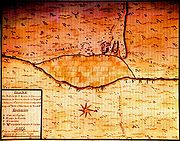
Pima Indian Revolt
Encyclopedia

Pima
The Pima are a group of American Indians living in an area consisting of what is now central and southern Arizona. The long name, "Akimel O'odham", means "river people". They are closely related to the Tohono O'odham and the Hia C-ed O'odham...
native American
Indigenous peoples of the Americas
The indigenous peoples of the Americas are the pre-Columbian inhabitants of North and South America, their descendants and other ethnic groups who are identified with those peoples. Indigenous peoples are known in Canada as Aboriginal peoples, and in the United States as Native Americans...
s in 1751 against colonial forces in Spanish Arizona
Spanish period of Arizona
In the late 18th century, colonists began steadily entering the region of northern New Spain that is the modern-day U.S. state of Arizona. They were attracted by reports of the discovery of deposits of silver around the Arizonac mining camp...
and one of the major northern frontier conflicts in early New
New Spain
New Spain, formally called the Viceroyalty of New Spain , was a viceroyalty of the Spanish colonial empire, comprising primarily territories in what was known then as 'América Septentrional' or North America. Its capital was Mexico City, formerly Tenochtitlan, capital of the Aztec Empire...
Spain
Spain
Spain , officially the Kingdom of Spain languages]] under the European Charter for Regional or Minority Languages. In each of these, Spain's official name is as follows:;;;;;;), is a country and member state of the European Union located in southwestern Europe on the Iberian Peninsula...
.
Background
The revolt was a culmination of a period of low-level violence against the local Spanish settlers since 1684. The period was characterized by a gradual loss of autonomy and territory by the Native Americans, as treaties allowing mining and herding by the Spanish on native lands were eroded by an influx of new settlers; by 1760 Spaniards and Mexicans outnumbered Native Americans in the present-day American Southwest. However, the colonial province of SonoraSonora
Sonora officially Estado Libre y Soberano de Sonora is one of the 31 states which, with the Federal District, comprise the 32 Federal Entities of Mexico. It is divided into 72 municipalities; the capital city is Hermosillo....
was characterized by a larger native population, and more frequent conflict between them and the Spaniards. The Pima Indian Revolt was directly preceded by the Seri Revolt of Seri Indians in Sonora.
Uprising
While the Pima people had no central authority, the charismatic Luis Oacpicagigua (Luis of Sáric) began the task of uniting—with varying degrees of success—the disparate groups, numbering at least 15,000 people, under a single war plan. The initial act of rebellion was the massacre of 18 settlers lured to Oacpicagigua's home in SáricSáric
Sáric is a small town and the municipal area around it, located in the extreme north of the Mexican state of Sonora. Its northern boundary is the U.S. state of Arizona. The population of the municipality was 2,703 in 2010 living in an area of 1,676.23 square kilometers. The elevation is...
. In the ensuing three months, Oacpicagigua and more than a hundred other men attacked the mission at Tubutama
Tubutama
Tubutama is a town, and the surrounding municipality of the same name, in the north-west of the Mexican state of Sonora. It was founded in the late 17th century by Fr. Francisco Eusebio Kino...
, and other Spanish settlements, and more than a hundred settlers were killed. Oacpicagigua surrendered to Captain José Díaz del Carpio on March 18, 1752 after a negotiated peace. When the Pima leaders laid the blame for the revolt on Jesuit missionaries
Missionary
A missionary is a member of a religious group sent into an area to do evangelism or ministries of service, such as education, literacy, social justice, health care and economic development. The word "mission" originates from 1598 when the Jesuits sent members abroad, derived from the Latin...
(who would be expelled from Spain and its colonies in 1767) they were pardoned by the colonial governor Ortiz Parrilla.
After the conflict
Small scale conflict soon began again, however, and Oacpicagigua eventually died in a Spanish prison in 1755. The colonial government founded three new presidioPresidio
A presidio is a fortified base established by the Spanish in North America between the sixteenth and nineteenth centuries. The fortresses were built to protect against pirates, hostile native Americans and enemy colonists. Other presidios were held by Spain in the sixteenth and seventeenth...
s in Sonora to control the Pima and Seri populace in the years after the revolt: San Ignacio de Tubac, Santa Gertrudis de Altar, and San Carlos de Buenavista, present-day Tubac, Arizona
Tubac, Arizona
Tubac is a census-designated place in Santa Cruz County, Arizona, United States. The population was 949 at the 2000 census. The place name Tubac is an English borrowing from a Hispanicized form of the O'odham name, which translates into English as "rotten". The original O'odham name is written...
, Altar, Sonora
Altar, Sonora
Altar is small city in Altar Municipality in the Mexican state of Sonora. It is located in the northwest region of the state at . Surrounding municipalities are Sáric, Tubutama, Atil, Trincheras, Pitiquito, Caborca and Oquitoa. The northern boundary is with Pima County in the U.S...
, and Buenavista, Sonora, respectively. While intermittent rebellions continued, by the end of the eighteenth century, Sonoran natives had been largely missionized or Hispanicized, and the assimilated tribes of frontier New Spain were absorbed into the Spanish Empire
Spanish Empire
The Spanish Empire comprised territories and colonies administered directly by Spain in Europe, in America, Africa, Asia and Oceania. It originated during the Age of Exploration and was therefore one of the first global empires. At the time of Habsburgs, Spain reached the peak of its world power....
.

